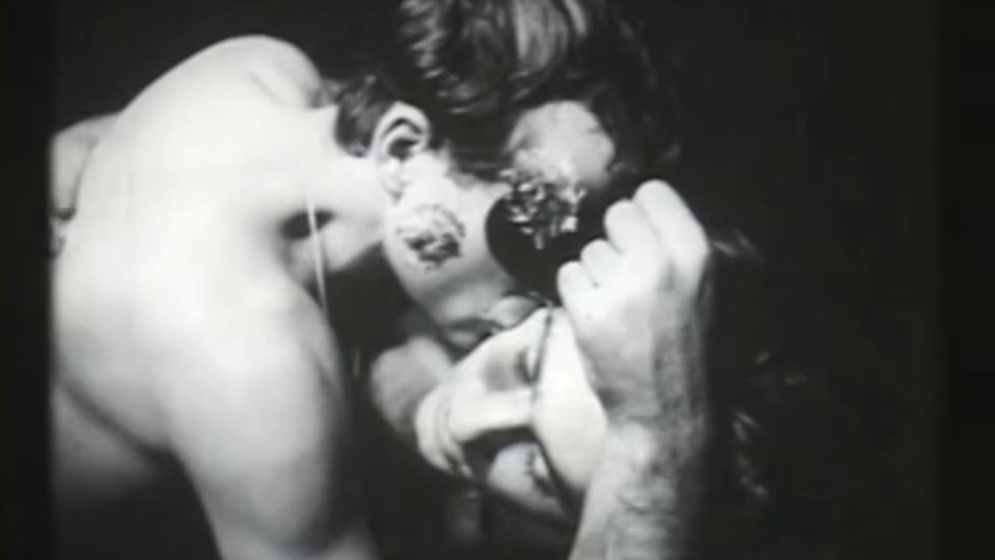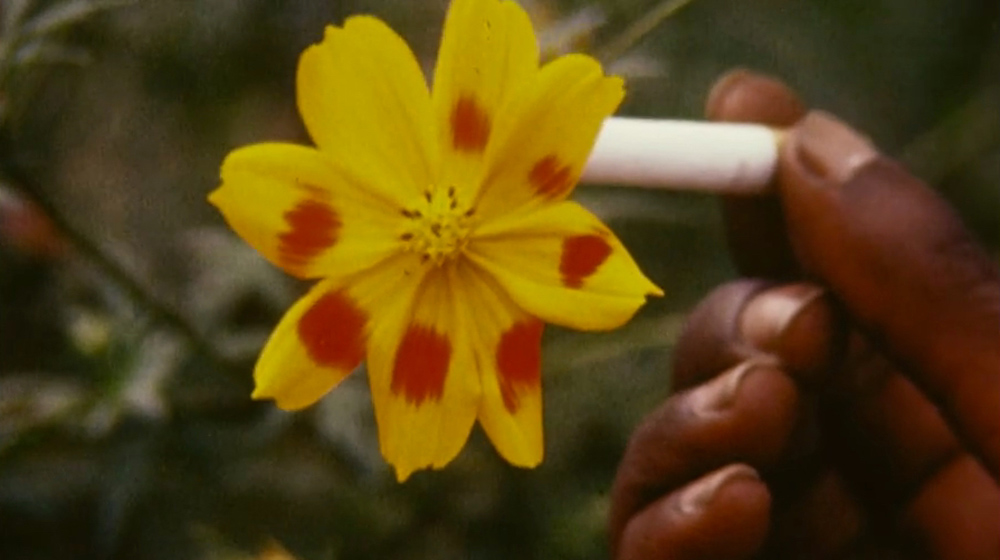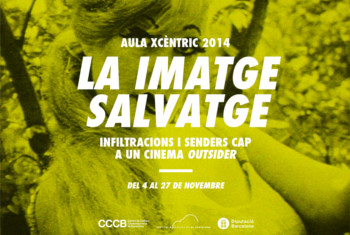In addition to being a technology of vision, a characteristic scopic apparatus of modernity, the cinema has always been an architecture of desire. Contributory factors are the conditions of screening, the intimate gloom in which people of various types and classes indiscriminately mix, and the oneiric nature of the image that encourages reverie, a state of physical abandon close to sensual availability. But most of all, as countless theorists of the medium have commented, it is largely the structure of the cinematographic apparatus that fundamentally determines its erotic nature: the positioning of the spectator as voyeur, the privileged viewer of other bodies and faces. The scene in Le sang d’un poète (Cocteau, 1933) where the poet in question spies through a keyhole on scenes of languid decadence—from opium smokers to a hieratic hermaphrodite creature—is an allegory of the cinematographic apparatus: the dramaturgy of seeing without being seen and delighting in bodies that are unaware of a stranger’s eyes.
But cinema is not just a device of the desiring gaze; it is also an eminently spatial medium that draws together more or less plausible places and guides the gaze through this virtual geography. According to Dziga Vertov, cinema is a means not just to “see” but also to “fly,” to simulate displacement and explore space. Perhaps this is why many of the early films recreated movement through space: from the train pulling into the station of La Ciotat, filmed by the Lumière brothers, to the numerous panoramic landscapes, exotic monuments, and bustling urban scenes that were produced in the early days of film. The evolution of cinema as an eminently narrative art as of the mid-1900s did not dim its spatial exploration, rather linking it to the adventures of fictional characters and the contemplation of their actions. Cinematographic space became that of characters moving through a story. The grammar of editing developed by the American School, headed by Griffith, brought the camera closer to the actors to be able to detail their actions and highlight their expressivity, but it also situated the characters precisely in space and offered spectators an optimum view, whether of the humanised, stylised space of the comedy or the musical, the natural space of the Western and adventure films, the urban setting of noir films, or the imaginary places of science fiction and fantasy. This optimum view consolidated the erotic nature of the cinema, since, in addition to telling the story, the succession of shots allowed spectators to consume, in a kind of symbolic cannibalism, the body and the movements of the stars.
These two visions of cinema—as a vehicle of desire and of spatial exploration—have tended to be considered separately, perhaps because they do not seem to be mutually involved. Or perhaps because both space and sexuality, and their mutual and inevitable involvement—all sexuality and desire necessarily have a place—are sublimated in commercial cinema, particularly the kind that follows the narrative system of classic Hollywood, adopted as an almost global standard. In mainstream cinema, sex and space have a subterranean existence. They condition the narrative to a large extent but they are also relegated to the fringes. They may take centre stage, as when an outpouring of passion or an erotic encounter embodies a climax in the action—or even the entire plot—or when the landscape takes over the screen. But they tend to act more like unconscious substrates of the story; they mark it discreetly, without making their presence felt too strongly.
This discretion may be a reaction to the disorienting power of the spatial continuum and sexuality alike. Both contain the possibility of diversion, dilation, infinite flirtation, multiple paths, philias and links. Conventional cinema has tended to regulate this possible disorder: from an infinite spatial range, it selects an almost unfaltering path that follows the movement of the characters; likewise, from a broad spectrum of sexualities, it chooses compulsive heterosexuality and gender dimorphism (woman-man). The linear advance of the consumer narrative through subordinate spaces of the plot, which neither divert nor halt it, is perfectly congruent with the way in which desire and sexuality course through standardised, conventional channels. For example, the wild chase of Roger Thornhill (Cary Grant) around a variety of US landscapes in North by Northwest (Hitchcock, 1959), famously taking in the huge effigies of the American presidents at Mount Rushmore, culminates in a sexual encounter between him and Eve Kendall (Eve Marie Saint), underlined in the film by an image of their train entering a tunnel. The narrative guides the plot and its spaces to bring the couple together. It glosses over the seductions of space, through which the story rushes, and those of the sexual ambiguity of the pursuers (the affected villain played by James Mason and his sombre henchman, Martin Landau). As numerous feminist and queer analyses have repeatedly shown, consumer cinema is all too frequently a technology for fixing gender and erotic experience. It has reduced an infinite field to a few predetermined paths, and this sexual limitation—and it is important to remember this—rests on a comparable restriction of the possibility of spatial divagation.
The films that are made on the fringe, however, are open to the precise opposite: to expansive flight, to spatial divagation and to sexual nomadism. With its power of contestation and resistance, experimental film, instead of sublimating space and sex, makes them incidental to the unfolding of a story, often placing them in the forefront, at the same time disintegrating and atomising the possibility of the narrative by means of diversions and digressions that are, at once, spatial and erotic.
At the start of Fred Halsted’s extraordinary film, Los Angeles Plays Itself (1972), the camera’s roving gaze explores wooded mountainsides, shrouded in mist. This gaze discovers, as though by accident, two men wandering through the woods who eventually meet and meld in a sexual encounter. Sex does not subordinate the natural setting, nor does the latter become a mere stage for eroticism. The images of nature that surround them are placed on the same level of interest as their bodies and the sexual act, which often gives way to the setting: plants, insects, a river flowing between the rocks. In the second part of the film, the wandering takes place in the city, taking us to the streets where rent boys hang out, to gay cruising areas, and, finally, to a park where musicians of hippie appearance are playing and young people are relaxing in the sun. These urban scenes, often charged with eroticism (the image lingers on the bare torsos of the young men in the park), are cut with a sadomasochistic encounter between Halsted himself and his lover Joe Yale. This scene is, in turn, occasionally relegated by detailed shots of the room where this is happening: enigmatic mechanical objects, shadows on the parquet, reflected light, scattered clothes. Other shots have an ironic or symbolic intention: comic strips, posters and newspaper headlines allude to S&M practices, while preserved insects, pinned in place, suggest allegories of submission.
Like Halsted’s film, Extreme Private Eros: A Love Song 1974 (Hara, 1974) also moves back and forth between private and public spaces, between the street and the interiors where its characters live. The initial purpose of this action documentary, as its maker called it to indicate that he was an active part of the events he was filming, was therapeutic. By making it, Hara sought to clarify his relation with the main character, Japanese radical feminist Takeda Miyuki, who suddenly left him just months before filming began, taking their child with her. The film recounts Miyuki’s life in the months following the breakup. Hara follows her from Tokyo, where they lived together, to the island of Okinawa, where Miyuki starts up a relationship with another woman, who then leaves her, and with an Afro-American marine, with whom she also breaks up, and by whom she becomes pregnant, though subsequently declaring she doesn’t know who the baby’s father is. On Okinawa, then a base for US soldiers bound for the war in Vietnam, Miyuki opens a day centre to look after the children of local women who work as waitresses, dancers and prostitutes in the bars frequented by soldiers, and tries to educate them in defence of their rights. After a confrontation with the local mafia, presumably opposed to her attempts to enlighten their workers, Miyuki returns to Tokyo, where her baby is born. (She is delighted that it’s a girl, that she has a strong character, and that she’s interracial, as opposed to the racial uniformity of her country.) In the film’s closing scenes, Miyuki moves with her two children to a feminist commune where she assists at the labour of Kobayashi, the film’s sound woman and Hara’s new partner. The film closes with a sequence showing the women in the commune living with the children who they look after collectively.
The film explores the characters’ privacy with shattering honesty. Miyuki and Hara discuss their feelings and settle past accounts in raw conversations that often move the director to tears. Miyuki gives birth before the camera, in a long, frontal shot that shows the baby come out and the mother’s efforts to expel the placenta. It is out of focus, since his nerves prevent Hara focusing properly. The film’s visual style reflects this dense humanity. Closed shots predominate, the microphysics of faces and bodies that touch and confront in congested interiors. Closeness encourages confidences, emotional nakedness and conflicts. It is obvious that there is still sexual tension between Hara and Miyuki, who openly declares her jealousy when Kobayashi becomes pregnant by Hara. Sometimes the action goes outside: to dark streets and the soldiers’ bars, to the beach where Miyuki and Kobayashi speak openly about their common relationship with Hara, and, towards the end of the film, to the streets of a wintry Tokyo. Open space also allows greater relaxation. Long sinuous shots follow the characters in their wanderings and their spontaneous contact with local people, soldiers, and with the sex workers whom Miyuki wants to help.
This back-and-forth between interiors and exteriors and the reference to recognisable coordinates disappear in filmmakers who prefer to explore spaces with no real references. In Lucifer Rising, Anger creates a spatial collage that fluidly unites interiors where purifying spells and rituals are performed, and exteriors where nature is stirred, monuments of a magical past rise up and the initiates invoke the force that gives the film its name. The continuity between these spaces is symbolic rather than geographical. Located in distant places, the magi describe similar gestures, like visual echoes that impose a particular rhythm on the flow of the image, or continue the actions begun by others, unifying a heterogeneous, disperse world with the symmetry of the rituals. This geography compacted by magic—including the magic of Anger’s virtuoso editing—is packed with erotic insinuations, represented above all by the young men who occasionally display their nakedness in a ritual bath or smile invitingly at the camera with an eroticism which, rather than interrupting, actually prolongs the initiatory impulse. In Anger, sex is always transcendent and esoteric.
Anger’s cosmic seriousness finds a festive counterpoint in Flaming Creatures and Christmas on Earth. Both recreate sex not as magic or a telluric force, but as play and comedy. Both are set in indeterminate places, like the harem-brothel-port tavern-Hollywood studio inhabited by ghosts of the past that is the setting for Flaming Creatures, or the black box of Christmas, where the only discernible architecture is provided by the anatomy of the participants in the orgiastic mêlée that the film portrays. Transvestism, masquerade and an effervescent sexual ambiguity reign in both. The bodies are fragmented, curiously recombined, disfigured by paint and makeup (in Christmas), and subjected to an erotic decentralisation, because as much attention is paid to the genitals as to any other part of the bodily morphology. The fantastic location of these orgies is reinforced by the screening protocol used in Christmas: a double-screen work with one frame projected inside another, as though indicating that the scenes have no possible external correlate beyond the moment when they are viewed. This isolation from reality affirms the power of sexual fantasy, but it also relegates it to a space apart, exiled from real life. As Smith was well aware—Flaming Creatures was prosecuted and censored for its alleged immorality—US reality of the time was not ready for the erotic utopia proposed by underground cinema. And it is still not today.
Brakhage’s Sexual Meditations (1970-1972) tend to remain indoors, this time recognisable: hotels, bedrooms, a friend’s living room, a businessman’s office. Only “Open Field” ventures into a natural space: a field on the edge of a wood where naked children and adolescents play. Both this idyllic place and the more prosaic ones mentioned above are dominated by the filmmaker’s subjectivity. Filmed with his characteristic fleeting, nervously moving shots, often superimposed, and interspersed with black squares, Brakhage's images evoke the barely definable impressions, memories and feelings that these places communicate. The subjective and slightly oneiric nature of these meditations is accentuated by the graininess (some of the series’ fragments were filmed in 8mm and then blown up to 16mm) and the use of a piece of painted glass as a filter. The sexuality of these meditations moves between the sublimated (in “Faun’s Room”), the ephemeral (the phantasmal nude in “Office Suite”; fragments of body glimpsed in “Hotel Room”), the playful (discretely comic poses and evolutions in “Room with View”), and the lyrical (the children in “Open Field”, who, to quote the filmmaker, also evoke the awakening of sensuality and adult nostalgia for this lost moment). While the filmmakers discussed above explore sexuality as a presence, as a dramatic force and tactile sensation, Brakhage evokes it more as absence, as a shadow given off by places once habited by desire.
With the exception of Flaming Creatures and Christmas on Earth, most of the works discussed here were produced in the early seventies. They are heirs to the disruptive aesthetics of the 1960s US underground, and to the sexual revolutions that began in the same decade and were consolidated in the seventies, with the rise of radical feminism, and gay and lesbian liberation fronts. These films recall a time when visual and social experimentation went hand in hand. Feminism and gay and lesbian militancy alike radically transformed the perception of the spaces we live in, revealing the gender and sexual coding: the fact that most spaces were coded as markedly male or female and definitely heterosexist. In fact, as part of the effect of liberation, gay and lesbian communities began to create spaces of autonomy, community, or erotic liberation. The impulse of these revolutions pulsates in these films, in their aesthetic gambits, in their varied exploration of the complex territories of the intimate and the sexual, and also in their peculiar spatiality; all are factors that these films require us to consider together, and that perhaps should not—or cannot—be understood separately.
Juan Antonio Suárez





